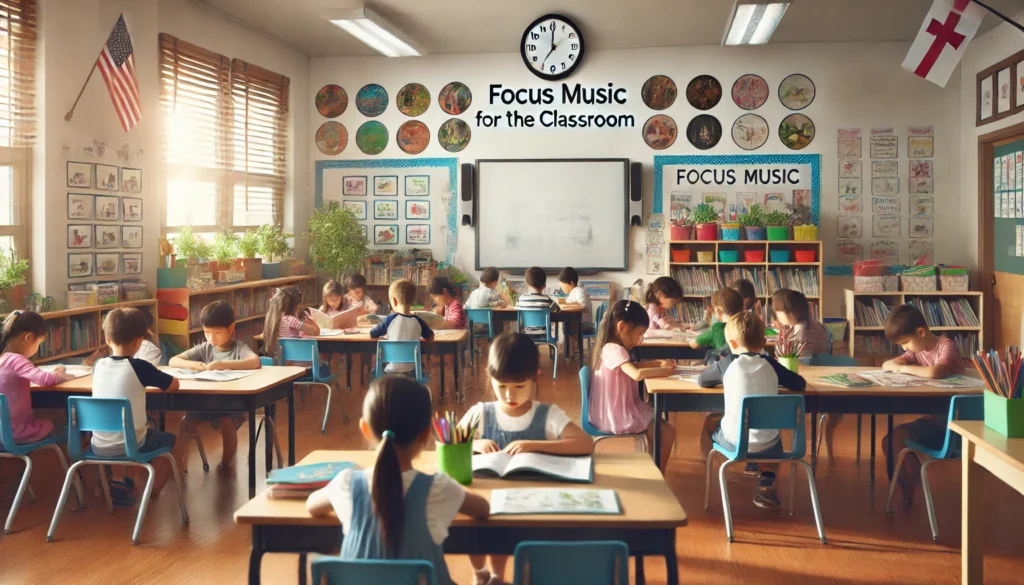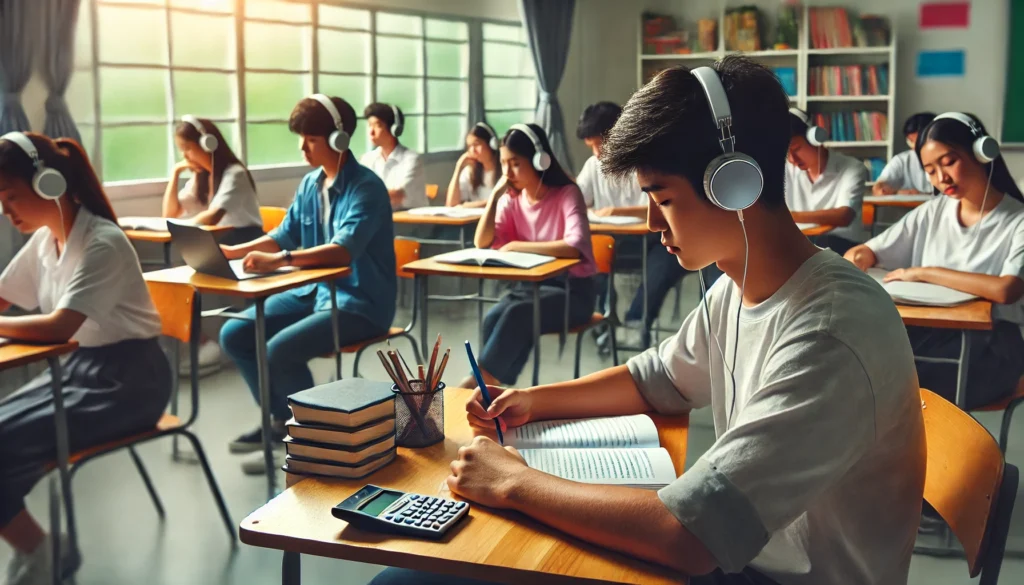In the realm of education, the quest for enhancing student productivity and focus is ceaseless. Among the various strategies employed to achieve this, the integration of music in the classroom has garnered significant attention. But does music truly have the power to transform a learning environment? Let’s delve into the intricate relationship between music and productivity, exploring how educators can harness the benefits of “concentration music” and “focus music for classroom” settings to optimize learning outcomes.
You may also like: Focus Music: Genres That Boost Concentration
The Historical Context of Music in Learning
Ancient Civilizations and Educational Practices
The use of music in educational settings is not a novel concept. Historically, music has been intertwined with learning processes, dating back to ancient civilizations. In societies such as Ancient Egypt and Mesopotamia, music was not only a form of entertainment but also an educational tool. Priests and scholars employed chants and songs to pass down knowledge and history, emphasizing the role of music in memory retention and learning.
The Greeks and the Harmony of Music and Mathematics
The Greeks believed in the harmonious balance of music and mathematics, advocating for its inclusion in their educational paradigms. Music was considered a vital component of a well-rounded education, fostering not only artistic skills but also cognitive and emotional development. Philosophers like Pythagoras explored the mathematical underpinnings of musical harmony, influencing educational practices and highlighting the connection between music and intellectual growth.
The Renaissance and the Evolution of Musical Education
During the Renaissance, the perception of music in education evolved further. As humanism gained prominence, education systems began to emphasize the arts, including music, as crucial elements of personal and intellectual development. Music was taught alongside other academic subjects, reflecting its importance in cultivating a well-rounded, culturally aware individual. This period laid the groundwork for modern educational philosophies that integrate music as a tool for enhancing learning.

How Music Influences Concentration and Focus
The Science Behind Music and Concentration
The science of how music influences cognitive functions is both fascinating and complex. Music engages several areas of the brain, including those responsible for attention, memory, and emotional processing. When utilized correctly, music can create an environment conducive to enhanced concentration and focus, particularly in classroom settings. Neuroimaging studies have shown that music activates the prefrontal cortex, which is involved in planning and decision-making, thereby supporting cognitive tasks and learning.
The Impact of Music on Brain Waves
Studies suggest that certain types of music, often referred to as “focus music,” can increase alpha wave activity in the brain. Alpha waves are associated with a state of relaxed alertness, which is ideal for absorbing information and sustaining focus. This makes music a powerful tool for educators aiming to improve student concentration during learning activities. Additionally, music can modulate theta waves, which are linked to creativity and problem-solving, further enhancing the learning experience.
The Role of Music in Reducing Anxiety
Music also plays a crucial role in reducing anxiety, which can otherwise hinder productivity and focus. During high-stakes situations such as testing, “testing music for classroom” settings can help alleviate stress, creating a calm environment where students can perform at their best. The soothing qualities of music can lower cortisol levels, a hormone associated with stress, thus promoting a more relaxed and productive state of mind. Music therapy techniques are increasingly being integrated into educational settings to support mental health and well-being.

Implementing Music Strategies in the Classroom
Choosing the Right Type of Music
The key to effectively using music in the classroom lies in selecting the appropriate type of music. Not all music is conducive to productivity; genres with complex lyrics or abrupt changes in tempo may serve as distractions rather than aids. Instead, instrumental music, ambient soundscapes, or classical pieces are often recommended for their ability to enhance focus without diverting attention. Educators should consider the specific needs and preferences of their students when selecting music to ensure it aligns with learning objectives.
Customizing Music for Diverse Learning Activities
It is also crucial to consider the preferences of students. Conducting a brief survey to gauge their musical tastes can provide valuable insights into what types of music might be most effective in your classroom. Tailoring music selections to different learning activities, such as reading, writing, or group work, can enhance the overall educational experience. For example, upbeat music might energize students during collaborative projects, while calming music could facilitate individual concentration during exams.
Practical Tips for Using Music in Education
- Time it Right: Introduce music during periods of independent work or creative tasks. Avoid using music during discussions or lectures where verbal communication is key. Timing is essential to ensure that music complements rather than competes with the primary educational activity.
- Volume Control: Keep the volume at a moderate level. Music should serve as a background element, not overpowering the primary task at hand. Adjusting the volume according to the classroom environment and activity can optimize the effectiveness of music as a learning aid.
- Observe and Adjust: Monitor the impact of music on student behavior and productivity. Be prepared to adjust your approach based on feedback and observations. Regularly soliciting student feedback and being open to experimentation can help refine music strategies to best support learning outcomes.
- Create Playlists: Curate playlists specifically designed for different classroom activities. For instance, create separate playlists for relaxation, concentration, and creativity. Utilizing digital platforms or streaming services can simplify playlist management and provide access to a wide range of musical options.

Current Trends and Future Implications
The Role of Technology in Music Integration
The integration of music in educational settings continues to evolve, driven by technological advancements and a growing understanding of cognitive science. Personalized learning experiences, facilitated by digital platforms, allow students to tailor their auditory environment to their individual needs, further enhancing productivity. Technologies such as AI and machine learning are being developed to analyze student behavior and recommend music that optimizes learning outcomes.
Research and Development in Music Education
As research progresses, we anticipate a future where music is seamlessly integrated into educational technologies, providing real-time feedback and adapting to the cognitive states of learners. This could lead to more personalized and effective educational experiences, where music plays a central role in optimizing learning outcomes. Ongoing research into the neurology of music and its impact on learning will continue to inform best practices and innovative approaches in education.
The Future of Music as a Learning Tool
With the potential of music in education becoming increasingly apparent, future implications include the development of curricula that incorporate music as a core component of learning. Educators and policymakers may explore collaborations with musicians, composers, and cognitive scientists to design educational programs that harness the full potential of music. This could revolutionize traditional teaching methods, making education more engaging and effective for diverse learners.
Conclusion
The power of music as a tool for enhancing classroom productivity and focus cannot be understated. By understanding the science behind music and concentration, and implementing strategic music choices, educators can create a more productive and engaging learning environment. As we continue to explore the potential of music in education, it is imperative to remain open to new insights and innovations that can further enrich the educational experience. Whether you are a health and wellness coach, a science journalist, or a biohacker, the intersection of music and learning offers promising avenues for optimizing mental and emotional well-being.
In embracing music as an educational tool, we acknowledge its capacity to transform traditional learning environments into dynamic spaces that nurture both cognitive and emotional growth. As educators, students, and researchers collaborate to unlock the full potential of music in education, the future holds exciting possibilities for creating more effective, inclusive, and enjoyable learning experiences.
Further Reading:
Can Music Help You Study and Focus?
Music brings harmony to language lessons for multilingual learners
Important Note: The information contained in this article is for general informational purposes only, and should not be construed as health or medical advice, nor is it intended to diagnose, prevent, treat, or cure any disease or health condition. Before embarking on any diet, fitness regimen, or program of nutritional supplementation, it is advisable to consult your healthcare professional in order to determine its safety and probable efficacy in terms of your individual state of health.
Regarding Nutritional Supplements Or Other Non-Prescription Health Products: If any nutritional supplements or other non-prescription health products are mentioned in the foregoing article, any claims or statements made about them have not been evaluated by the U.S. Food and Drug Administration, and such nutritional supplements or other health products are not intended to diagnose, treat, cure, or prevent any disease.


